Assessing Negligence in the Context of Contributory Negligence
VerifiedAdded on 2019/11/26
|14
|2814
|349
Report
AI Summary
The assignment discusses the concept of contributory negligence in Australian law, particularly with regards to section 9 of the Civil Liability Act 2003. The court considers several factors when determining whether a person has been guilty of contributory negligence, including the chances of harm, seriousness of the harm, and the burden imposed on the party for taking precautions against the risk of harm. The assignment also refers to case laws such as Wills v Bell & Ors [2002] QCA 419 and Jackson v McDonald's Australia Ltd [2014] NSWCA 162 to illustrate the application of these principles. In the context of the present case, Mrs. Lena Breitenfeldt can file a claim against the Wonder town Junior Cricket Club (WJCC) club for the negligent actions of its employees, but her claim would be reduced up to the extent of contributory negligence. The assignment also touches upon the concepts of duty of care and vicarious liability.
Contribute Materials
Your contribution can guide someone’s learning journey. Share your
documents today.
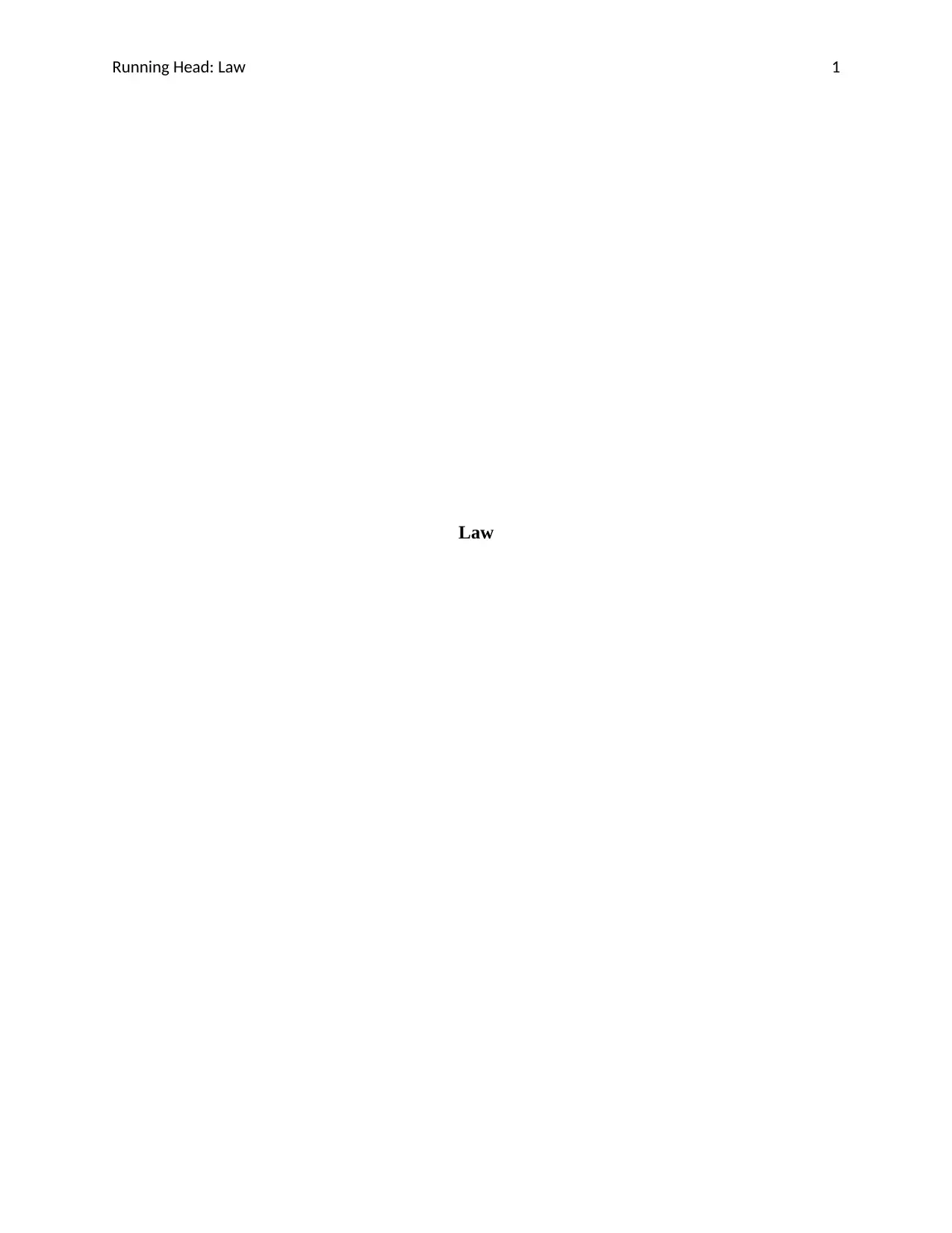
Running Head: Law 1
Law
Law
Secure Best Marks with AI Grader
Need help grading? Try our AI Grader for instant feedback on your assignments.
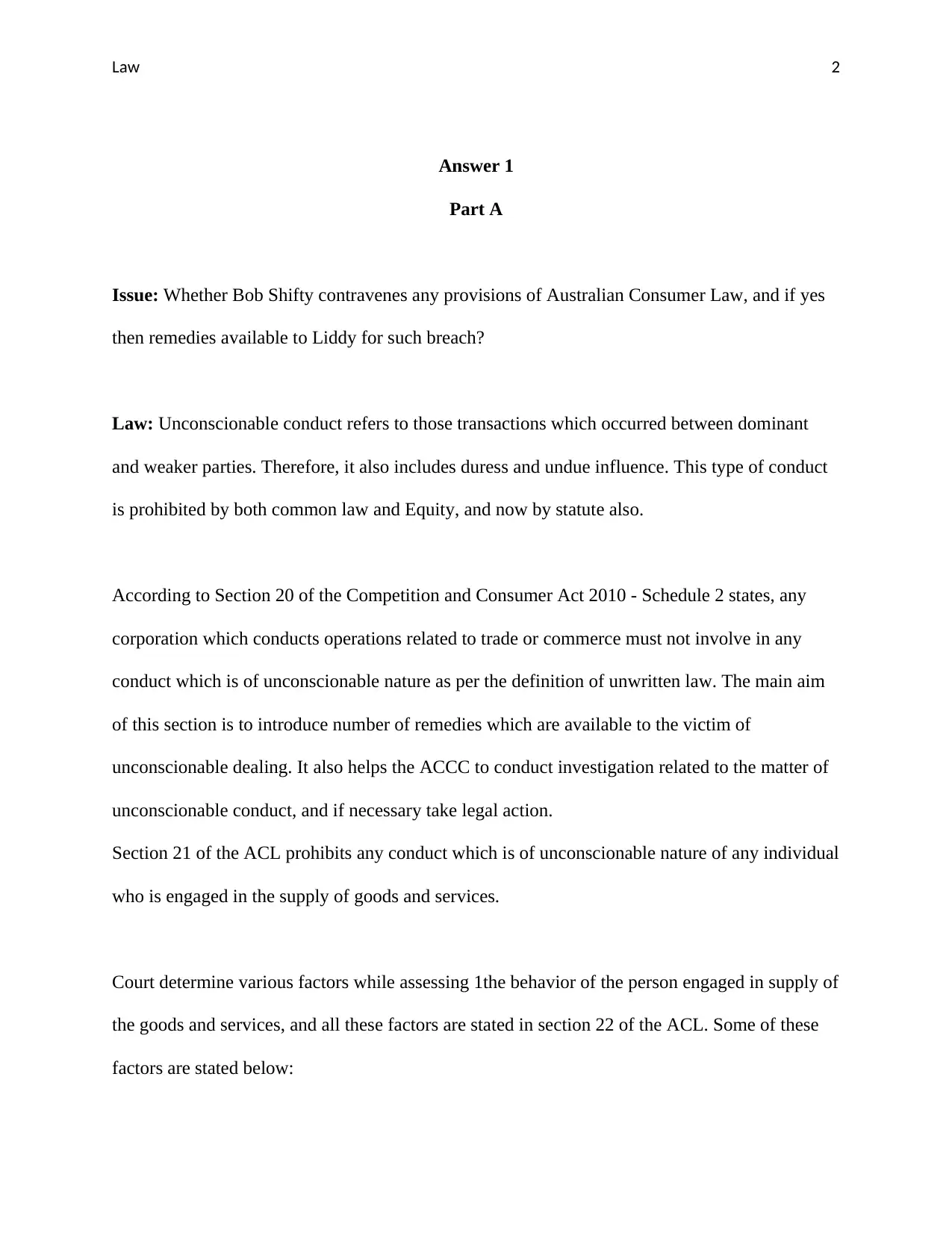
Law 2
Answer 1
Part A
Issue: Whether Bob Shifty contravenes any provisions of Australian Consumer Law, and if yes
then remedies available to Liddy for such breach?
Law: Unconscionable conduct refers to those transactions which occurred between dominant
and weaker parties. Therefore, it also includes duress and undue influence. This type of conduct
is prohibited by both common law and Equity, and now by statute also.
According to Section 20 of the Competition and Consumer Act 2010 - Schedule 2 states, any
corporation which conducts operations related to trade or commerce must not involve in any
conduct which is of unconscionable nature as per the definition of unwritten law. The main aim
of this section is to introduce number of remedies which are available to the victim of
unconscionable dealing. It also helps the ACCC to conduct investigation related to the matter of
unconscionable conduct, and if necessary take legal action.
Section 21 of the ACL prohibits any conduct which is of unconscionable nature of any individual
who is engaged in the supply of goods and services.
Court determine various factors while assessing 1the behavior of the person engaged in supply of
the goods and services, and all these factors are stated in section 22 of the ACL. Some of these
factors are stated below:
Answer 1
Part A
Issue: Whether Bob Shifty contravenes any provisions of Australian Consumer Law, and if yes
then remedies available to Liddy for such breach?
Law: Unconscionable conduct refers to those transactions which occurred between dominant
and weaker parties. Therefore, it also includes duress and undue influence. This type of conduct
is prohibited by both common law and Equity, and now by statute also.
According to Section 20 of the Competition and Consumer Act 2010 - Schedule 2 states, any
corporation which conducts operations related to trade or commerce must not involve in any
conduct which is of unconscionable nature as per the definition of unwritten law. The main aim
of this section is to introduce number of remedies which are available to the victim of
unconscionable dealing. It also helps the ACCC to conduct investigation related to the matter of
unconscionable conduct, and if necessary take legal action.
Section 21 of the ACL prohibits any conduct which is of unconscionable nature of any individual
who is engaged in the supply of goods and services.
Court determine various factors while assessing 1the behavior of the person engaged in supply of
the goods and services, and all these factors are stated in section 22 of the ACL. Some of these
factors are stated below:
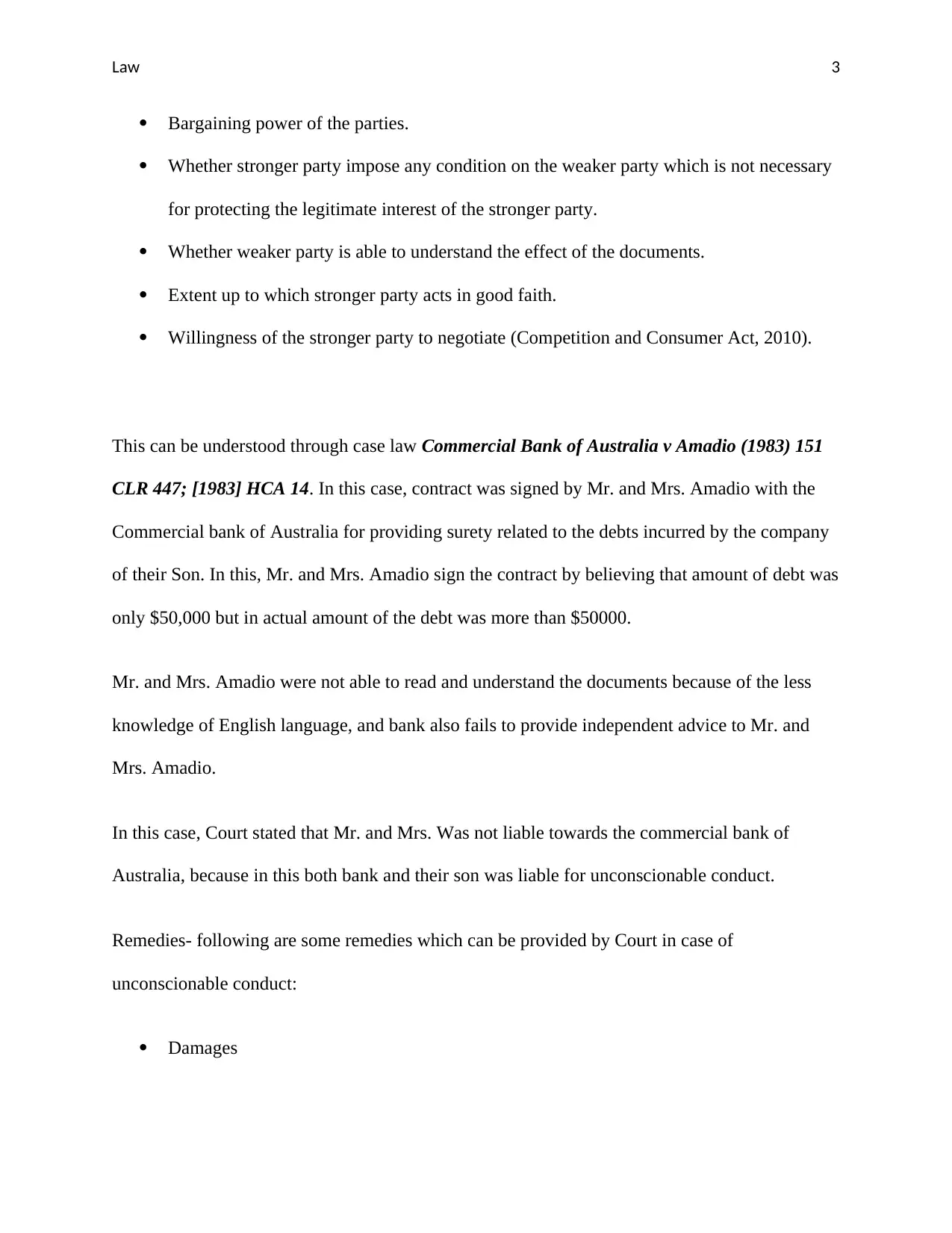
Law 3
Bargaining power of the parties.
Whether stronger party impose any condition on the weaker party which is not necessary
for protecting the legitimate interest of the stronger party.
Whether weaker party is able to understand the effect of the documents.
Extent up to which stronger party acts in good faith.
Willingness of the stronger party to negotiate (Competition and Consumer Act, 2010).
This can be understood through case law Commercial Bank of Australia v Amadio (1983) 151
CLR 447; [1983] HCA 14. In this case, contract was signed by Mr. and Mrs. Amadio with the
Commercial bank of Australia for providing surety related to the debts incurred by the company
of their Son. In this, Mr. and Mrs. Amadio sign the contract by believing that amount of debt was
only $50,000 but in actual amount of the debt was more than $50000.
Mr. and Mrs. Amadio were not able to read and understand the documents because of the less
knowledge of English language, and bank also fails to provide independent advice to Mr. and
Mrs. Amadio.
In this case, Court stated that Mr. and Mrs. Was not liable towards the commercial bank of
Australia, because in this both bank and their son was liable for unconscionable conduct.
Remedies- following are some remedies which can be provided by Court in case of
unconscionable conduct:
Damages
Bargaining power of the parties.
Whether stronger party impose any condition on the weaker party which is not necessary
for protecting the legitimate interest of the stronger party.
Whether weaker party is able to understand the effect of the documents.
Extent up to which stronger party acts in good faith.
Willingness of the stronger party to negotiate (Competition and Consumer Act, 2010).
This can be understood through case law Commercial Bank of Australia v Amadio (1983) 151
CLR 447; [1983] HCA 14. In this case, contract was signed by Mr. and Mrs. Amadio with the
Commercial bank of Australia for providing surety related to the debts incurred by the company
of their Son. In this, Mr. and Mrs. Amadio sign the contract by believing that amount of debt was
only $50,000 but in actual amount of the debt was more than $50000.
Mr. and Mrs. Amadio were not able to read and understand the documents because of the less
knowledge of English language, and bank also fails to provide independent advice to Mr. and
Mrs. Amadio.
In this case, Court stated that Mr. and Mrs. Was not liable towards the commercial bank of
Australia, because in this both bank and their son was liable for unconscionable conduct.
Remedies- following are some remedies which can be provided by Court in case of
unconscionable conduct:
Damages
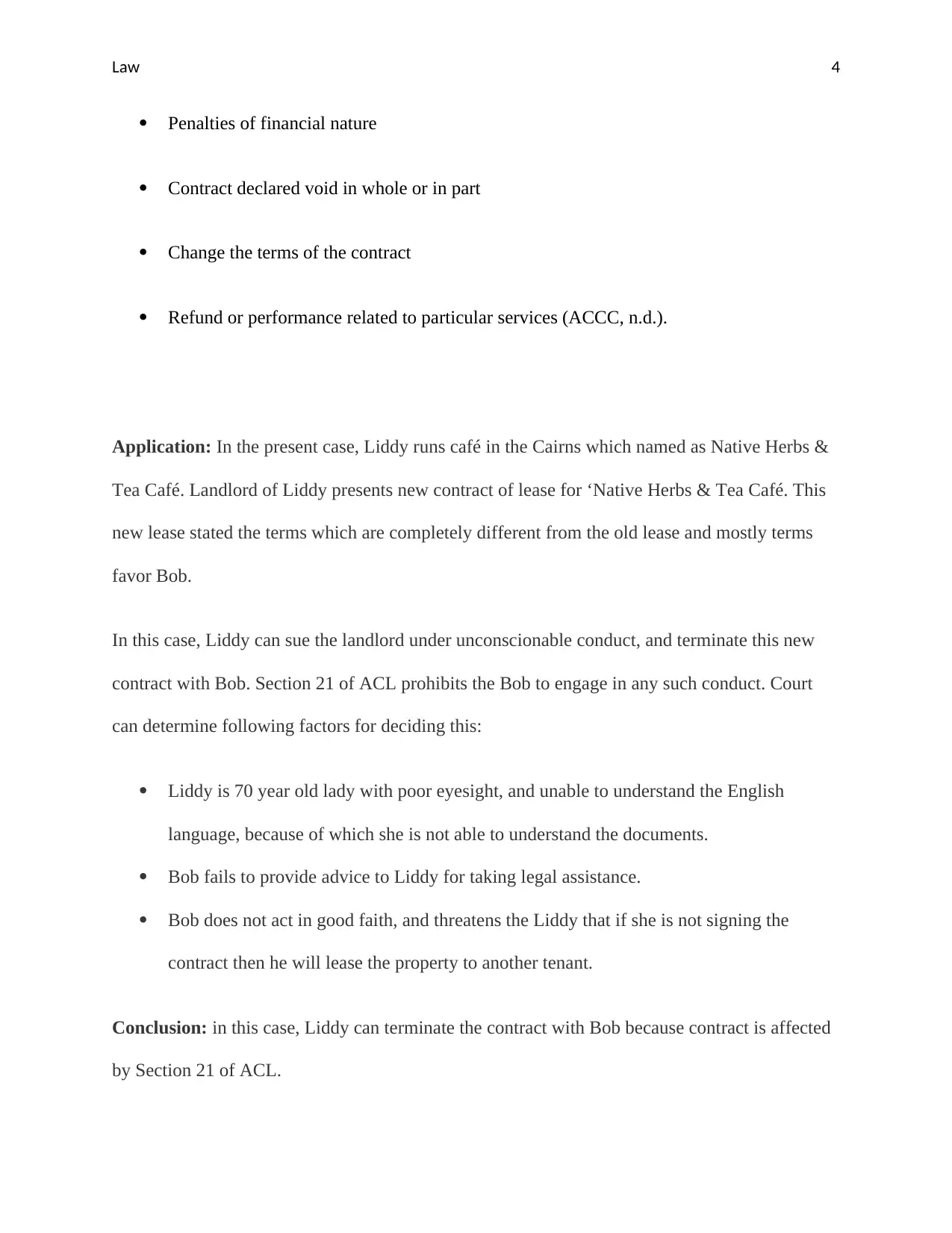
Law 4
Penalties of financial nature
Contract declared void in whole or in part
Change the terms of the contract
Refund or performance related to particular services (ACCC, n.d.).
Application: In the present case, Liddy runs café in the Cairns which named as Native Herbs &
Tea Café. Landlord of Liddy presents new contract of lease for ‘Native Herbs & Tea Café. This
new lease stated the terms which are completely different from the old lease and mostly terms
favor Bob.
In this case, Liddy can sue the landlord under unconscionable conduct, and terminate this new
contract with Bob. Section 21 of ACL prohibits the Bob to engage in any such conduct. Court
can determine following factors for deciding this:
Liddy is 70 year old lady with poor eyesight, and unable to understand the English
language, because of which she is not able to understand the documents.
Bob fails to provide advice to Liddy for taking legal assistance.
Bob does not act in good faith, and threatens the Liddy that if she is not signing the
contract then he will lease the property to another tenant.
Conclusion: in this case, Liddy can terminate the contract with Bob because contract is affected
by Section 21 of ACL.
Penalties of financial nature
Contract declared void in whole or in part
Change the terms of the contract
Refund or performance related to particular services (ACCC, n.d.).
Application: In the present case, Liddy runs café in the Cairns which named as Native Herbs &
Tea Café. Landlord of Liddy presents new contract of lease for ‘Native Herbs & Tea Café. This
new lease stated the terms which are completely different from the old lease and mostly terms
favor Bob.
In this case, Liddy can sue the landlord under unconscionable conduct, and terminate this new
contract with Bob. Section 21 of ACL prohibits the Bob to engage in any such conduct. Court
can determine following factors for deciding this:
Liddy is 70 year old lady with poor eyesight, and unable to understand the English
language, because of which she is not able to understand the documents.
Bob fails to provide advice to Liddy for taking legal assistance.
Bob does not act in good faith, and threatens the Liddy that if she is not signing the
contract then he will lease the property to another tenant.
Conclusion: in this case, Liddy can terminate the contract with Bob because contract is affected
by Section 21 of ACL.
Secure Best Marks with AI Grader
Need help grading? Try our AI Grader for instant feedback on your assignments.
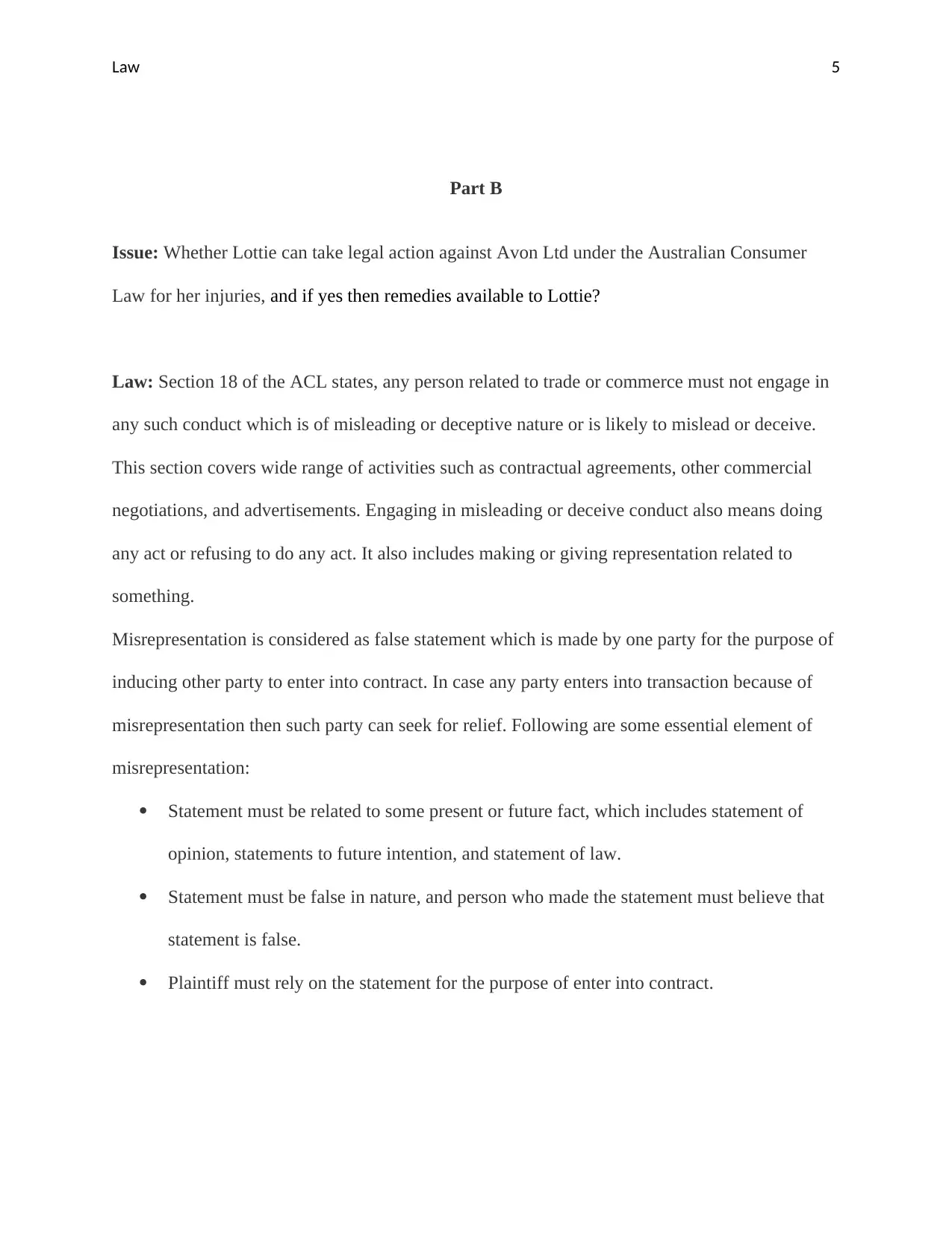
Law 5
Part B
Issue: Whether Lottie can take legal action against Avon Ltd under the Australian Consumer
Law for her injuries, and if yes then remedies available to Lottie?
Law: Section 18 of the ACL states, any person related to trade or commerce must not engage in
any such conduct which is of misleading or deceptive nature or is likely to mislead or deceive.
This section covers wide range of activities such as contractual agreements, other commercial
negotiations, and advertisements. Engaging in misleading or deceive conduct also means doing
any act or refusing to do any act. It also includes making or giving representation related to
something.
Misrepresentation is considered as false statement which is made by one party for the purpose of
inducing other party to enter into contract. In case any party enters into transaction because of
misrepresentation then such party can seek for relief. Following are some essential element of
misrepresentation:
Statement must be related to some present or future fact, which includes statement of
opinion, statements to future intention, and statement of law.
Statement must be false in nature, and person who made the statement must believe that
statement is false.
Plaintiff must rely on the statement for the purpose of enter into contract.
Part B
Issue: Whether Lottie can take legal action against Avon Ltd under the Australian Consumer
Law for her injuries, and if yes then remedies available to Lottie?
Law: Section 18 of the ACL states, any person related to trade or commerce must not engage in
any such conduct which is of misleading or deceptive nature or is likely to mislead or deceive.
This section covers wide range of activities such as contractual agreements, other commercial
negotiations, and advertisements. Engaging in misleading or deceive conduct also means doing
any act or refusing to do any act. It also includes making or giving representation related to
something.
Misrepresentation is considered as false statement which is made by one party for the purpose of
inducing other party to enter into contract. In case any party enters into transaction because of
misrepresentation then such party can seek for relief. Following are some essential element of
misrepresentation:
Statement must be related to some present or future fact, which includes statement of
opinion, statements to future intention, and statement of law.
Statement must be false in nature, and person who made the statement must believe that
statement is false.
Plaintiff must rely on the statement for the purpose of enter into contract.
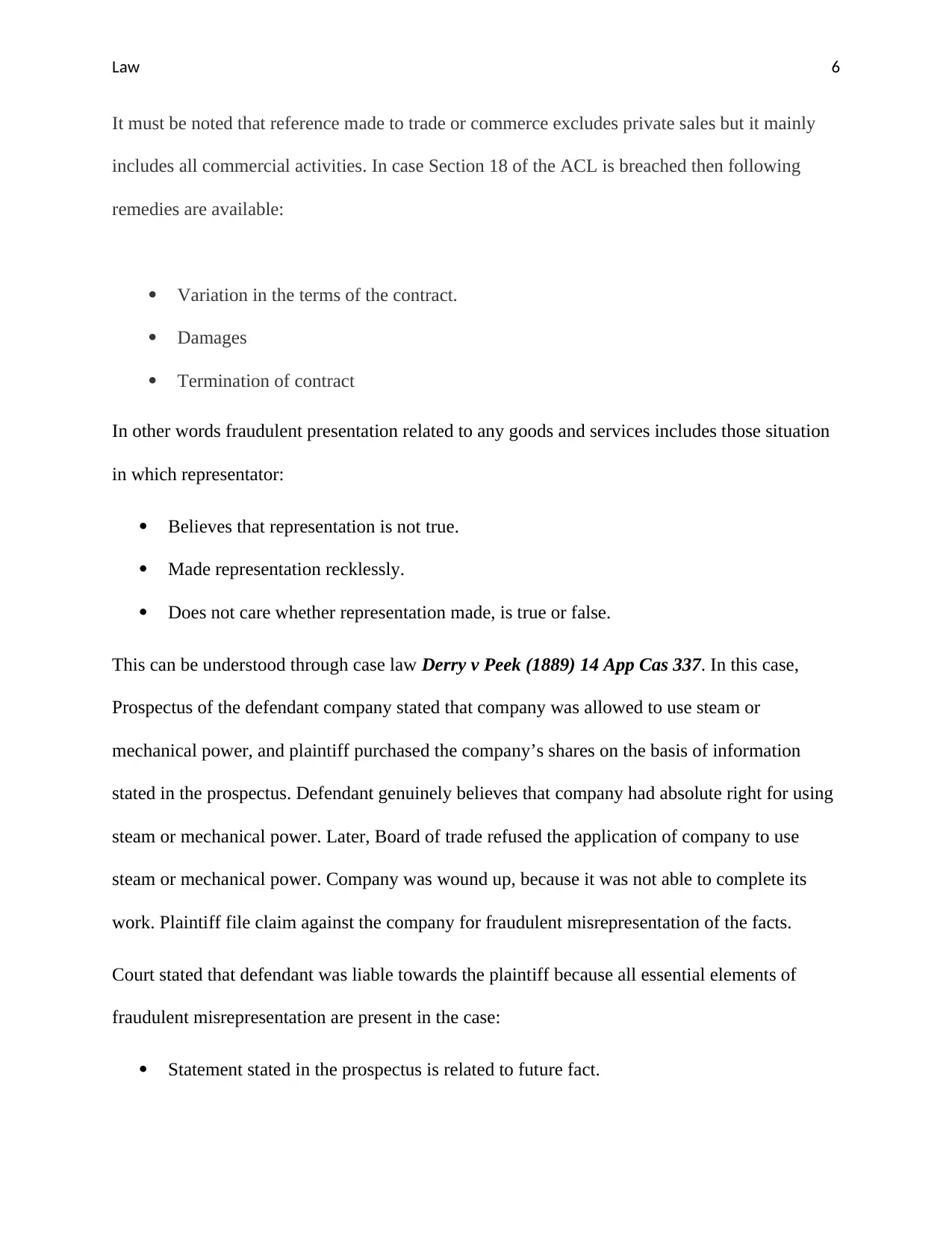
Law 6
It must be noted that reference made to trade or commerce excludes private sales but it mainly
includes all commercial activities. In case Section 18 of the ACL is breached then following
remedies are available:
Variation in the terms of the contract.
Damages
Termination of contract
In other words fraudulent presentation related to any goods and services includes those situation
in which representator:
Believes that representation is not true.
Made representation recklessly.
Does not care whether representation made, is true or false.
This can be understood through case law Derry v Peek (1889) 14 App Cas 337. In this case,
Prospectus of the defendant company stated that company was allowed to use steam or
mechanical power, and plaintiff purchased the company’s shares on the basis of information
stated in the prospectus. Defendant genuinely believes that company had absolute right for using
steam or mechanical power. Later, Board of trade refused the application of company to use
steam or mechanical power. Company was wound up, because it was not able to complete its
work. Plaintiff file claim against the company for fraudulent misrepresentation of the facts.
Court stated that defendant was liable towards the plaintiff because all essential elements of
fraudulent misrepresentation are present in the case:
Statement stated in the prospectus is related to future fact.
It must be noted that reference made to trade or commerce excludes private sales but it mainly
includes all commercial activities. In case Section 18 of the ACL is breached then following
remedies are available:
Variation in the terms of the contract.
Damages
Termination of contract
In other words fraudulent presentation related to any goods and services includes those situation
in which representator:
Believes that representation is not true.
Made representation recklessly.
Does not care whether representation made, is true or false.
This can be understood through case law Derry v Peek (1889) 14 App Cas 337. In this case,
Prospectus of the defendant company stated that company was allowed to use steam or
mechanical power, and plaintiff purchased the company’s shares on the basis of information
stated in the prospectus. Defendant genuinely believes that company had absolute right for using
steam or mechanical power. Later, Board of trade refused the application of company to use
steam or mechanical power. Company was wound up, because it was not able to complete its
work. Plaintiff file claim against the company for fraudulent misrepresentation of the facts.
Court stated that defendant was liable towards the plaintiff because all essential elements of
fraudulent misrepresentation are present in the case:
Statement stated in the prospectus is related to future fact.
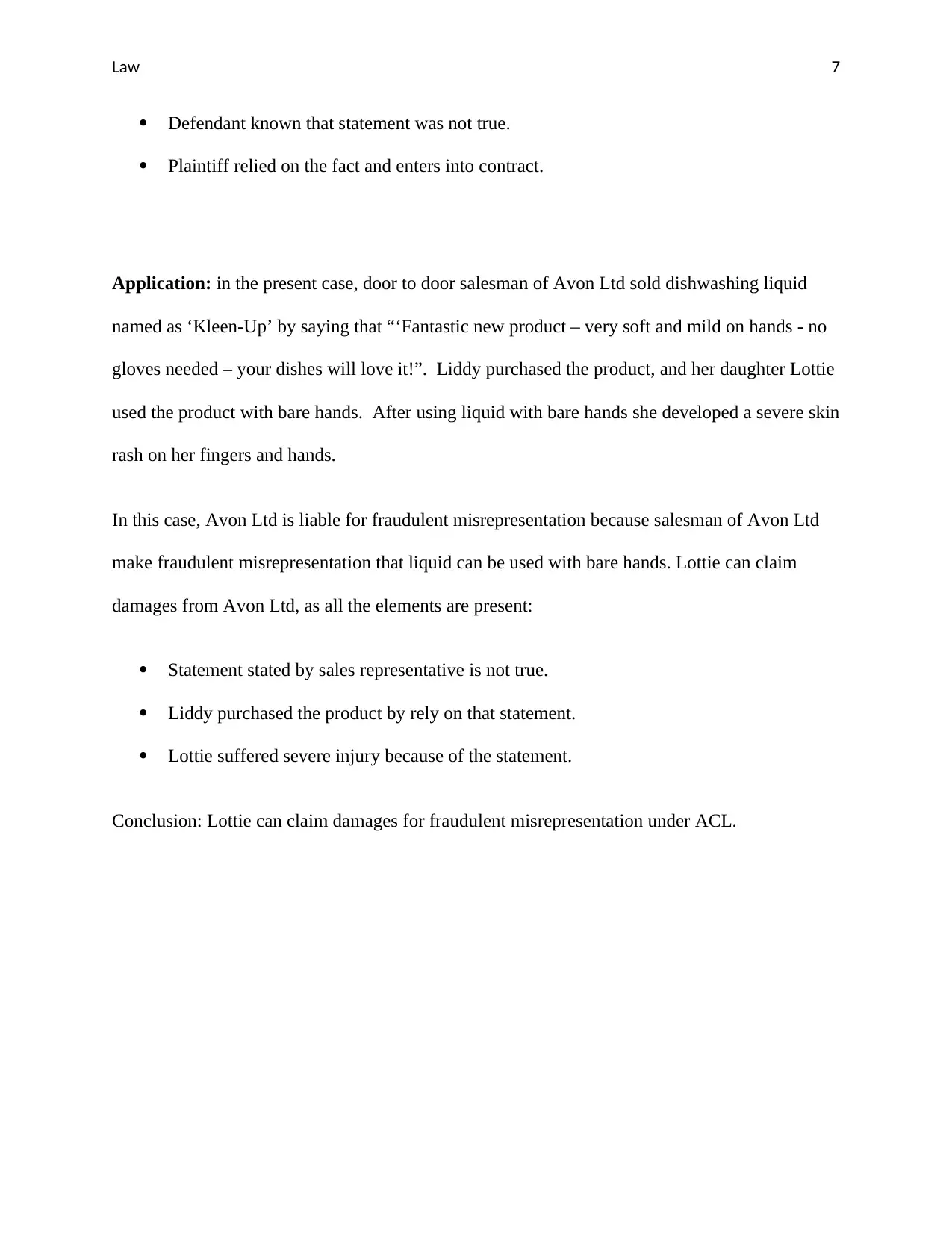
Law 7
Defendant known that statement was not true.
Plaintiff relied on the fact and enters into contract.
Application: in the present case, door to door salesman of Avon Ltd sold dishwashing liquid
named as ‘Kleen-Up’ by saying that “‘Fantastic new product – very soft and mild on hands - no
gloves needed – your dishes will love it!”. Liddy purchased the product, and her daughter Lottie
used the product with bare hands. After using liquid with bare hands she developed a severe skin
rash on her fingers and hands.
In this case, Avon Ltd is liable for fraudulent misrepresentation because salesman of Avon Ltd
make fraudulent misrepresentation that liquid can be used with bare hands. Lottie can claim
damages from Avon Ltd, as all the elements are present:
Statement stated by sales representative is not true.
Liddy purchased the product by rely on that statement.
Lottie suffered severe injury because of the statement.
Conclusion: Lottie can claim damages for fraudulent misrepresentation under ACL.
Defendant known that statement was not true.
Plaintiff relied on the fact and enters into contract.
Application: in the present case, door to door salesman of Avon Ltd sold dishwashing liquid
named as ‘Kleen-Up’ by saying that “‘Fantastic new product – very soft and mild on hands - no
gloves needed – your dishes will love it!”. Liddy purchased the product, and her daughter Lottie
used the product with bare hands. After using liquid with bare hands she developed a severe skin
rash on her fingers and hands.
In this case, Avon Ltd is liable for fraudulent misrepresentation because salesman of Avon Ltd
make fraudulent misrepresentation that liquid can be used with bare hands. Lottie can claim
damages from Avon Ltd, as all the elements are present:
Statement stated by sales representative is not true.
Liddy purchased the product by rely on that statement.
Lottie suffered severe injury because of the statement.
Conclusion: Lottie can claim damages for fraudulent misrepresentation under ACL.
Paraphrase This Document
Need a fresh take? Get an instant paraphrase of this document with our AI Paraphraser
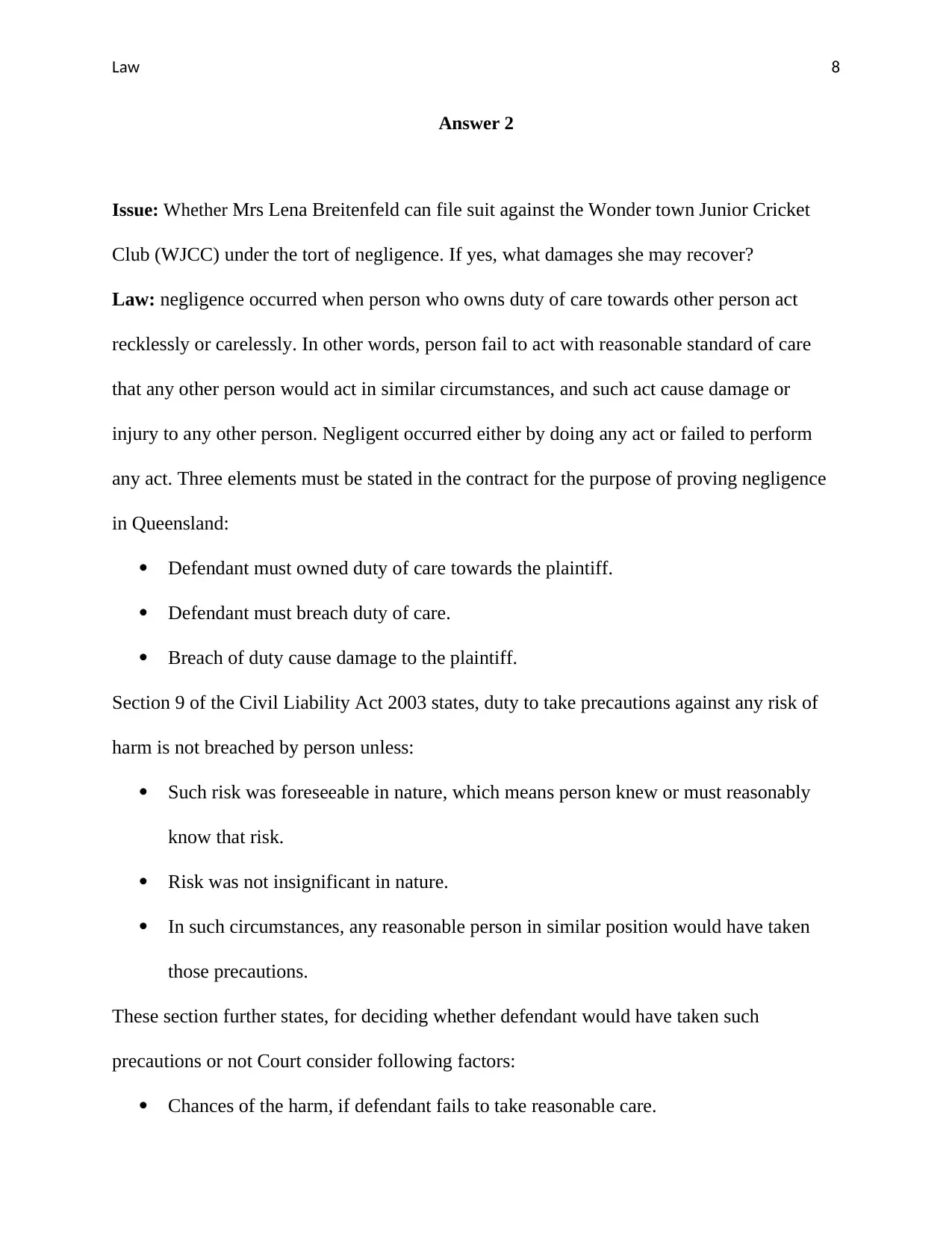
Law 8
Answer 2
Issue: Whether Mrs Lena Breitenfeld can file suit against the Wonder town Junior Cricket
Club (WJCC) under the tort of negligence. If yes, what damages she may recover?
Law: negligence occurred when person who owns duty of care towards other person act
recklessly or carelessly. In other words, person fail to act with reasonable standard of care
that any other person would act in similar circumstances, and such act cause damage or
injury to any other person. Negligent occurred either by doing any act or failed to perform
any act. Three elements must be stated in the contract for the purpose of proving negligence
in Queensland:
Defendant must owned duty of care towards the plaintiff.
Defendant must breach duty of care.
Breach of duty cause damage to the plaintiff.
Section 9 of the Civil Liability Act 2003 states, duty to take precautions against any risk of
harm is not breached by person unless:
Such risk was foreseeable in nature, which means person knew or must reasonably
know that risk.
Risk was not insignificant in nature.
In such circumstances, any reasonable person in similar position would have taken
those precautions.
These section further states, for deciding whether defendant would have taken such
precautions or not Court consider following factors:
Chances of the harm, if defendant fails to take reasonable care.
Answer 2
Issue: Whether Mrs Lena Breitenfeld can file suit against the Wonder town Junior Cricket
Club (WJCC) under the tort of negligence. If yes, what damages she may recover?
Law: negligence occurred when person who owns duty of care towards other person act
recklessly or carelessly. In other words, person fail to act with reasonable standard of care
that any other person would act in similar circumstances, and such act cause damage or
injury to any other person. Negligent occurred either by doing any act or failed to perform
any act. Three elements must be stated in the contract for the purpose of proving negligence
in Queensland:
Defendant must owned duty of care towards the plaintiff.
Defendant must breach duty of care.
Breach of duty cause damage to the plaintiff.
Section 9 of the Civil Liability Act 2003 states, duty to take precautions against any risk of
harm is not breached by person unless:
Such risk was foreseeable in nature, which means person knew or must reasonably
know that risk.
Risk was not insignificant in nature.
In such circumstances, any reasonable person in similar position would have taken
those precautions.
These section further states, for deciding whether defendant would have taken such
precautions or not Court consider following factors:
Chances of the harm, if defendant fails to take reasonable care.
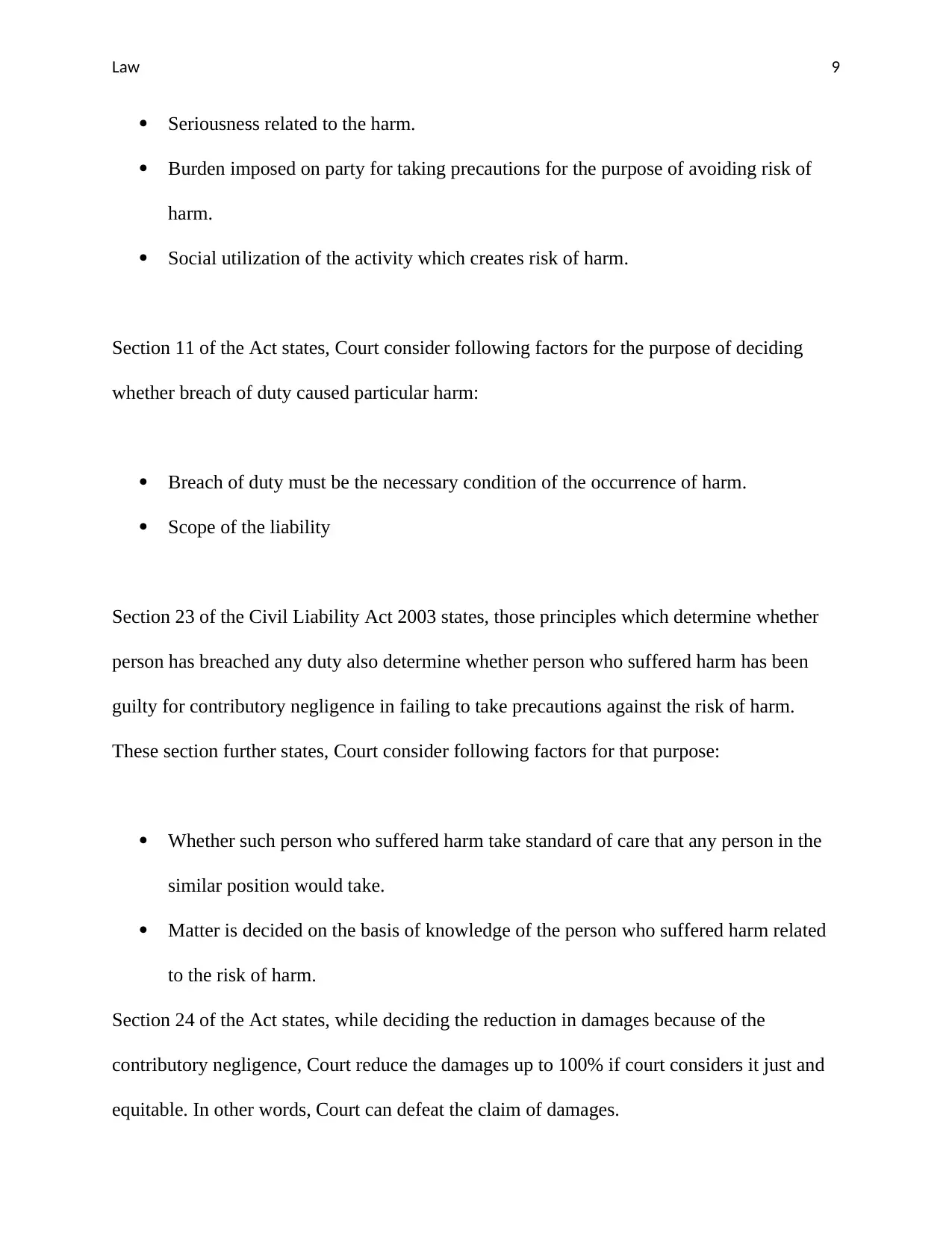
Law 9
Seriousness related to the harm.
Burden imposed on party for taking precautions for the purpose of avoiding risk of
harm.
Social utilization of the activity which creates risk of harm.
Section 11 of the Act states, Court consider following factors for the purpose of deciding
whether breach of duty caused particular harm:
Breach of duty must be the necessary condition of the occurrence of harm.
Scope of the liability
Section 23 of the Civil Liability Act 2003 states, those principles which determine whether
person has breached any duty also determine whether person who suffered harm has been
guilty for contributory negligence in failing to take precautions against the risk of harm.
These section further states, Court consider following factors for that purpose:
Whether such person who suffered harm take standard of care that any person in the
similar position would take.
Matter is decided on the basis of knowledge of the person who suffered harm related
to the risk of harm.
Section 24 of the Act states, while deciding the reduction in damages because of the
contributory negligence, Court reduce the damages up to 100% if court considers it just and
equitable. In other words, Court can defeat the claim of damages.
Seriousness related to the harm.
Burden imposed on party for taking precautions for the purpose of avoiding risk of
harm.
Social utilization of the activity which creates risk of harm.
Section 11 of the Act states, Court consider following factors for the purpose of deciding
whether breach of duty caused particular harm:
Breach of duty must be the necessary condition of the occurrence of harm.
Scope of the liability
Section 23 of the Civil Liability Act 2003 states, those principles which determine whether
person has breached any duty also determine whether person who suffered harm has been
guilty for contributory negligence in failing to take precautions against the risk of harm.
These section further states, Court consider following factors for that purpose:
Whether such person who suffered harm take standard of care that any person in the
similar position would take.
Matter is decided on the basis of knowledge of the person who suffered harm related
to the risk of harm.
Section 24 of the Act states, while deciding the reduction in damages because of the
contributory negligence, Court reduce the damages up to 100% if court considers it just and
equitable. In other words, Court can defeat the claim of damages.
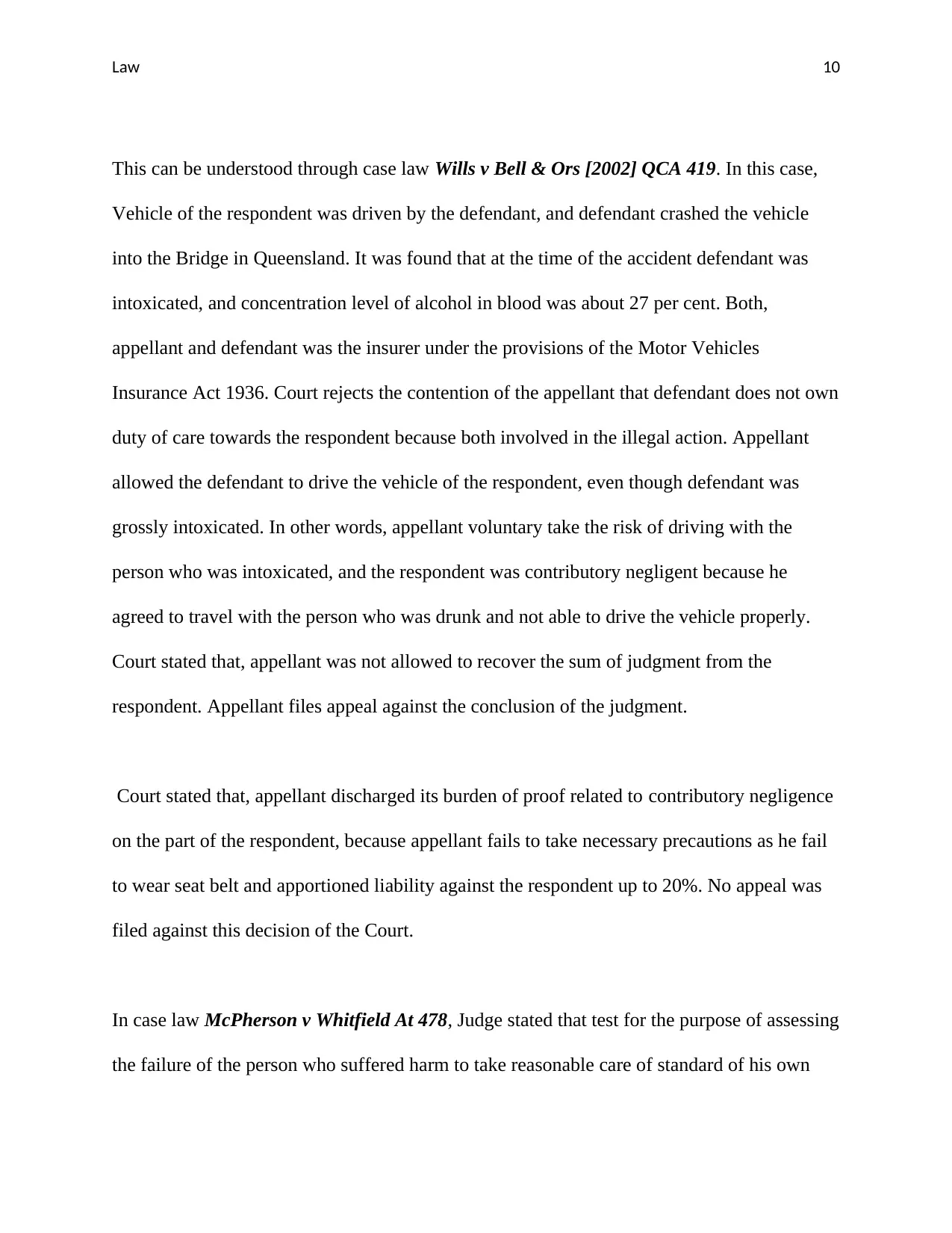
Law 10
This can be understood through case law Wills v Bell & Ors [2002] QCA 419. In this case,
Vehicle of the respondent was driven by the defendant, and defendant crashed the vehicle
into the Bridge in Queensland. It was found that at the time of the accident defendant was
intoxicated, and concentration level of alcohol in blood was about 27 per cent. Both,
appellant and defendant was the insurer under the provisions of the Motor Vehicles
Insurance Act 1936. Court rejects the contention of the appellant that defendant does not own
duty of care towards the respondent because both involved in the illegal action. Appellant
allowed the defendant to drive the vehicle of the respondent, even though defendant was
grossly intoxicated. In other words, appellant voluntary take the risk of driving with the
person who was intoxicated, and the respondent was contributory negligent because he
agreed to travel with the person who was drunk and not able to drive the vehicle properly.
Court stated that, appellant was not allowed to recover the sum of judgment from the
respondent. Appellant files appeal against the conclusion of the judgment.
Court stated that, appellant discharged its burden of proof related to contributory negligence
on the part of the respondent, because appellant fails to take necessary precautions as he fail
to wear seat belt and apportioned liability against the respondent up to 20%. No appeal was
filed against this decision of the Court.
In case law McPherson v Whitfield At 478, Judge stated that test for the purpose of assessing
the failure of the person who suffered harm to take reasonable care of standard of his own
This can be understood through case law Wills v Bell & Ors [2002] QCA 419. In this case,
Vehicle of the respondent was driven by the defendant, and defendant crashed the vehicle
into the Bridge in Queensland. It was found that at the time of the accident defendant was
intoxicated, and concentration level of alcohol in blood was about 27 per cent. Both,
appellant and defendant was the insurer under the provisions of the Motor Vehicles
Insurance Act 1936. Court rejects the contention of the appellant that defendant does not own
duty of care towards the respondent because both involved in the illegal action. Appellant
allowed the defendant to drive the vehicle of the respondent, even though defendant was
grossly intoxicated. In other words, appellant voluntary take the risk of driving with the
person who was intoxicated, and the respondent was contributory negligent because he
agreed to travel with the person who was drunk and not able to drive the vehicle properly.
Court stated that, appellant was not allowed to recover the sum of judgment from the
respondent. Appellant files appeal against the conclusion of the judgment.
Court stated that, appellant discharged its burden of proof related to contributory negligence
on the part of the respondent, because appellant fails to take necessary precautions as he fail
to wear seat belt and apportioned liability against the respondent up to 20%. No appeal was
filed against this decision of the Court.
In case law McPherson v Whitfield At 478, Judge stated that test for the purpose of assessing
the failure of the person who suffered harm to take reasonable care of standard of his own
Secure Best Marks with AI Grader
Need help grading? Try our AI Grader for instant feedback on your assignments.
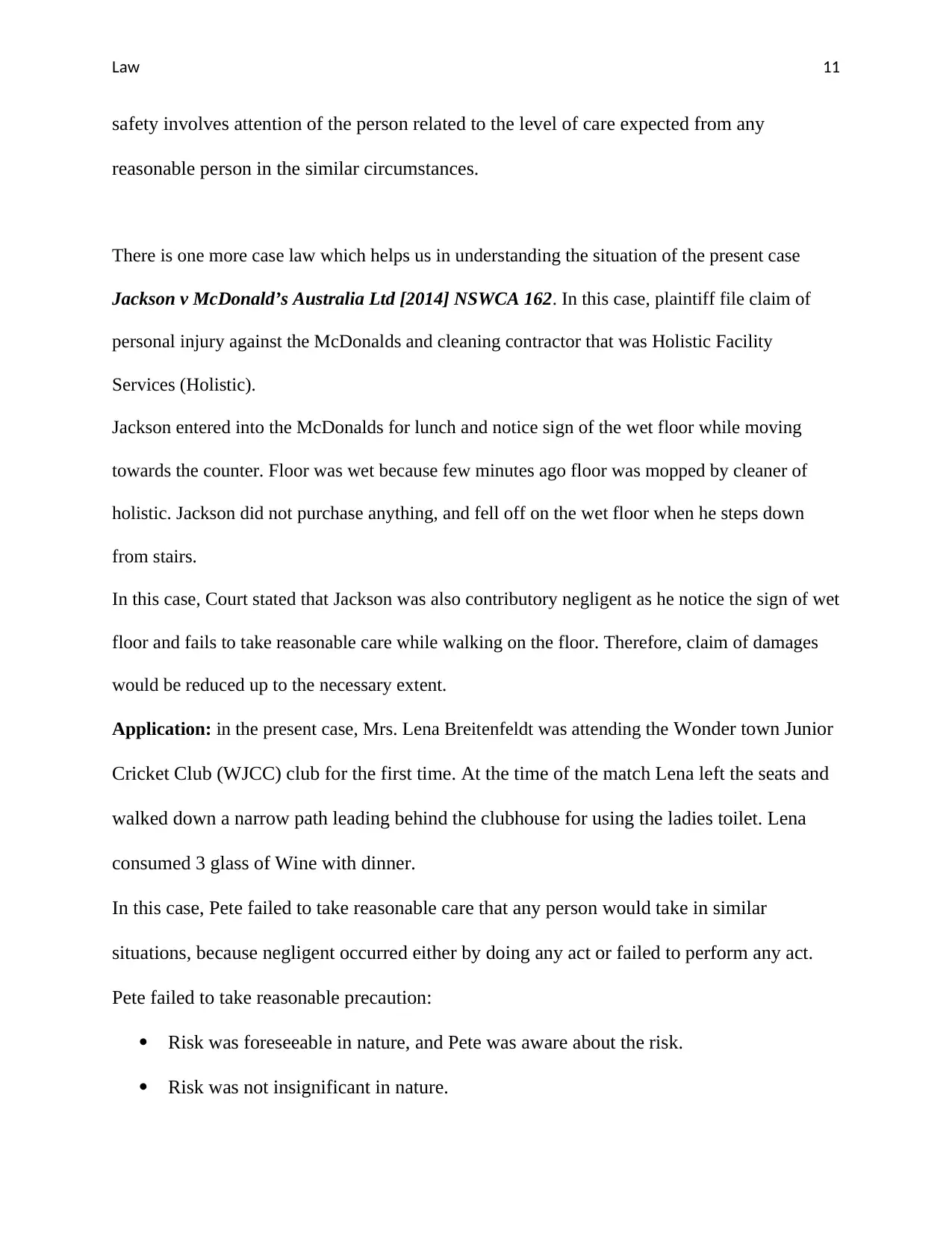
Law 11
safety involves attention of the person related to the level of care expected from any
reasonable person in the similar circumstances.
There is one more case law which helps us in understanding the situation of the present case
Jackson v McDonald’s Australia Ltd [2014] NSWCA 162. In this case, plaintiff file claim of
personal injury against the McDonalds and cleaning contractor that was Holistic Facility
Services (Holistic).
Jackson entered into the McDonalds for lunch and notice sign of the wet floor while moving
towards the counter. Floor was wet because few minutes ago floor was mopped by cleaner of
holistic. Jackson did not purchase anything, and fell off on the wet floor when he steps down
from stairs.
In this case, Court stated that Jackson was also contributory negligent as he notice the sign of wet
floor and fails to take reasonable care while walking on the floor. Therefore, claim of damages
would be reduced up to the necessary extent.
Application: in the present case, Mrs. Lena Breitenfeldt was attending the Wonder town Junior
Cricket Club (WJCC) club for the first time. At the time of the match Lena left the seats and
walked down a narrow path leading behind the clubhouse for using the ladies toilet. Lena
consumed 3 glass of Wine with dinner.
In this case, Pete failed to take reasonable care that any person would take in similar
situations, because negligent occurred either by doing any act or failed to perform any act.
Pete failed to take reasonable precaution:
Risk was foreseeable in nature, and Pete was aware about the risk.
Risk was not insignificant in nature.
safety involves attention of the person related to the level of care expected from any
reasonable person in the similar circumstances.
There is one more case law which helps us in understanding the situation of the present case
Jackson v McDonald’s Australia Ltd [2014] NSWCA 162. In this case, plaintiff file claim of
personal injury against the McDonalds and cleaning contractor that was Holistic Facility
Services (Holistic).
Jackson entered into the McDonalds for lunch and notice sign of the wet floor while moving
towards the counter. Floor was wet because few minutes ago floor was mopped by cleaner of
holistic. Jackson did not purchase anything, and fell off on the wet floor when he steps down
from stairs.
In this case, Court stated that Jackson was also contributory negligent as he notice the sign of wet
floor and fails to take reasonable care while walking on the floor. Therefore, claim of damages
would be reduced up to the necessary extent.
Application: in the present case, Mrs. Lena Breitenfeldt was attending the Wonder town Junior
Cricket Club (WJCC) club for the first time. At the time of the match Lena left the seats and
walked down a narrow path leading behind the clubhouse for using the ladies toilet. Lena
consumed 3 glass of Wine with dinner.
In this case, Pete failed to take reasonable care that any person would take in similar
situations, because negligent occurred either by doing any act or failed to perform any act.
Pete failed to take reasonable precaution:
Risk was foreseeable in nature, and Pete was aware about the risk.
Risk was not insignificant in nature.
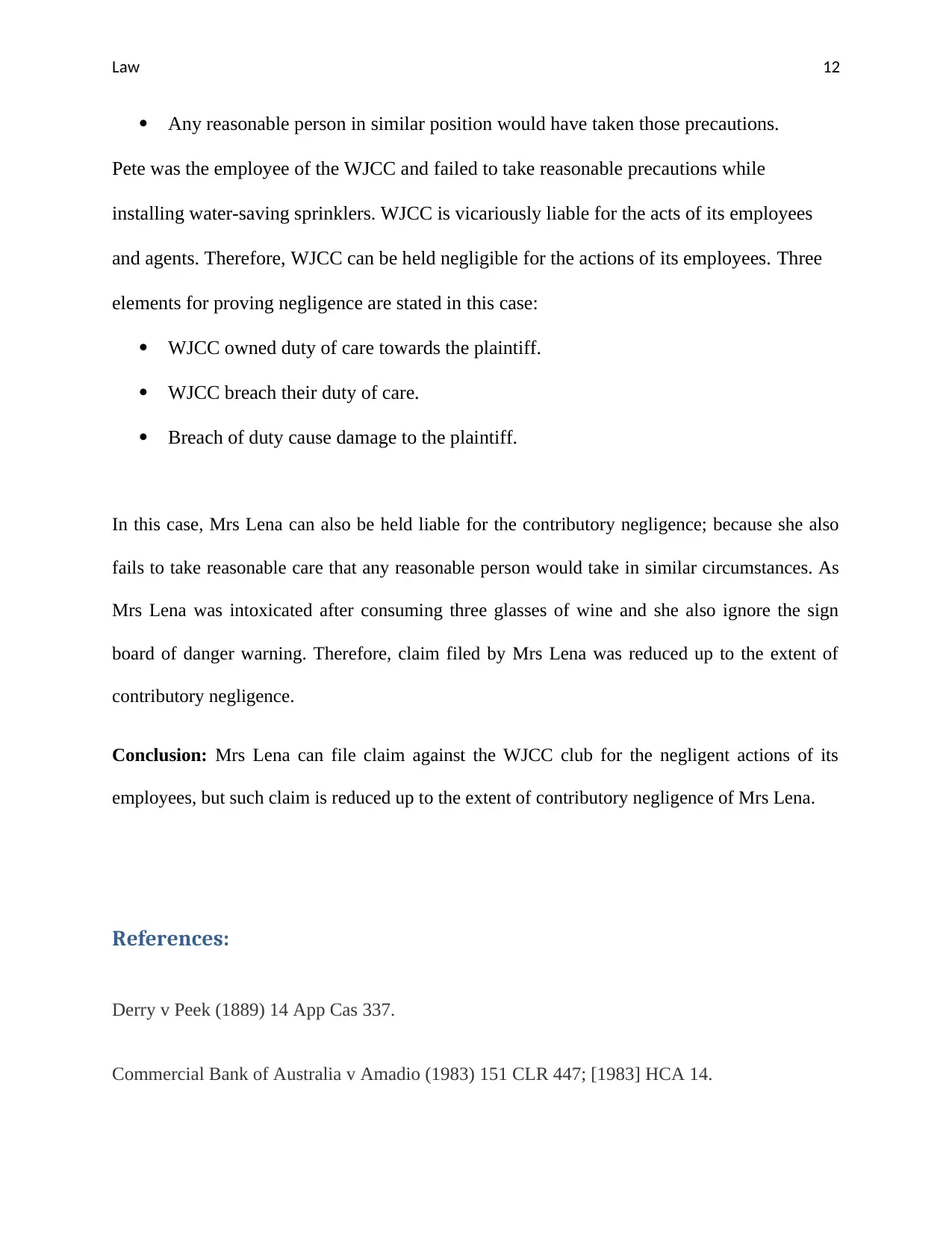
Law 12
Any reasonable person in similar position would have taken those precautions.
Pete was the employee of the WJCC and failed to take reasonable precautions while
installing water-saving sprinklers. WJCC is vicariously liable for the acts of its employees
and agents. Therefore, WJCC can be held negligible for the actions of its employees. Three
elements for proving negligence are stated in this case:
WJCC owned duty of care towards the plaintiff.
WJCC breach their duty of care.
Breach of duty cause damage to the plaintiff.
In this case, Mrs Lena can also be held liable for the contributory negligence; because she also
fails to take reasonable care that any reasonable person would take in similar circumstances. As
Mrs Lena was intoxicated after consuming three glasses of wine and she also ignore the sign
board of danger warning. Therefore, claim filed by Mrs Lena was reduced up to the extent of
contributory negligence.
Conclusion: Mrs Lena can file claim against the WJCC club for the negligent actions of its
employees, but such claim is reduced up to the extent of contributory negligence of Mrs Lena.
References:
Derry v Peek (1889) 14 App Cas 337.
Commercial Bank of Australia v Amadio (1983) 151 CLR 447; [1983] HCA 14.
Any reasonable person in similar position would have taken those precautions.
Pete was the employee of the WJCC and failed to take reasonable precautions while
installing water-saving sprinklers. WJCC is vicariously liable for the acts of its employees
and agents. Therefore, WJCC can be held negligible for the actions of its employees. Three
elements for proving negligence are stated in this case:
WJCC owned duty of care towards the plaintiff.
WJCC breach their duty of care.
Breach of duty cause damage to the plaintiff.
In this case, Mrs Lena can also be held liable for the contributory negligence; because she also
fails to take reasonable care that any reasonable person would take in similar circumstances. As
Mrs Lena was intoxicated after consuming three glasses of wine and she also ignore the sign
board of danger warning. Therefore, claim filed by Mrs Lena was reduced up to the extent of
contributory negligence.
Conclusion: Mrs Lena can file claim against the WJCC club for the negligent actions of its
employees, but such claim is reduced up to the extent of contributory negligence of Mrs Lena.
References:
Derry v Peek (1889) 14 App Cas 337.
Commercial Bank of Australia v Amadio (1983) 151 CLR 447; [1983] HCA 14.
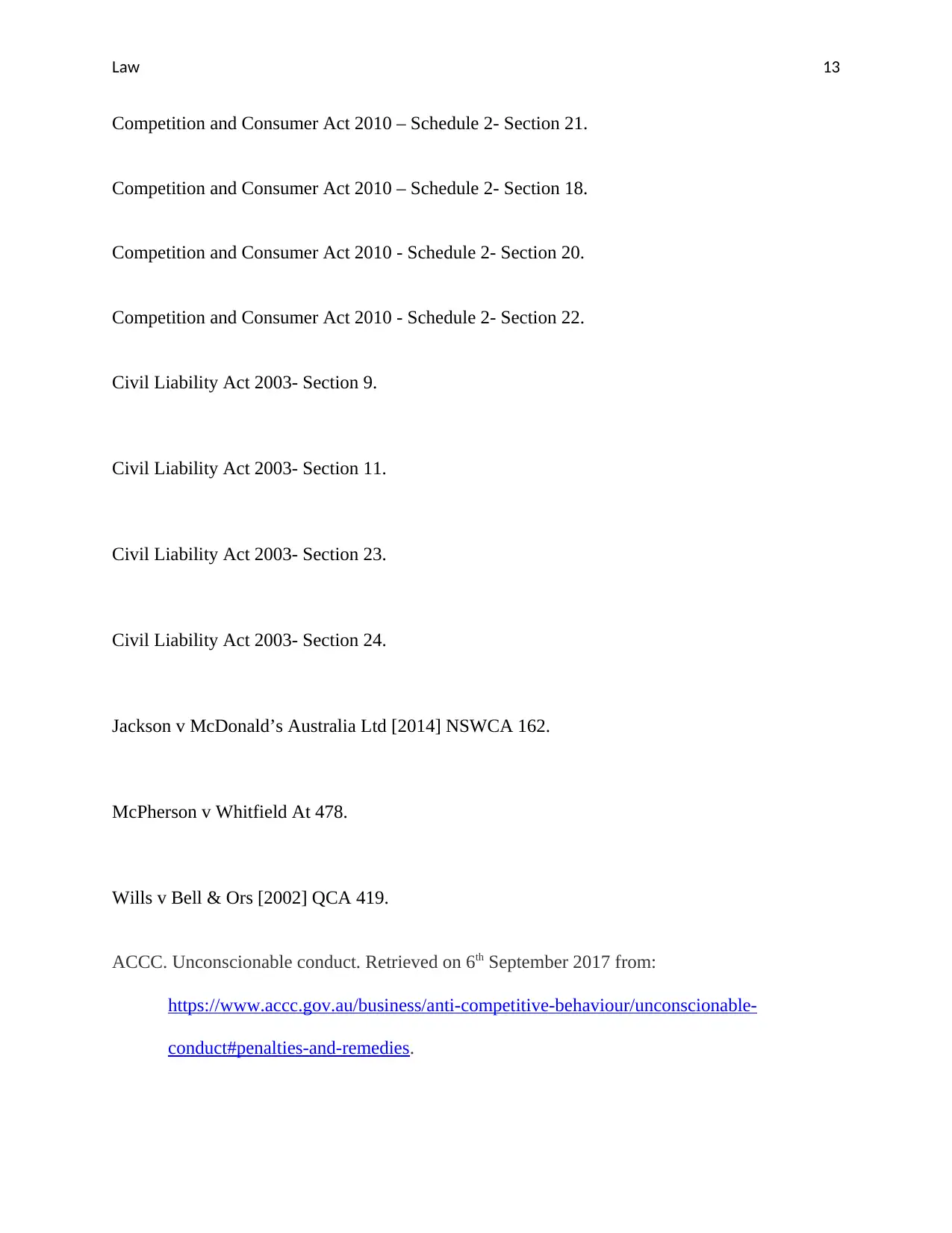
Law 13
Competition and Consumer Act 2010 – Schedule 2- Section 21.
Competition and Consumer Act 2010 – Schedule 2- Section 18.
Competition and Consumer Act 2010 - Schedule 2- Section 20.
Competition and Consumer Act 2010 - Schedule 2- Section 22.
Civil Liability Act 2003- Section 9.
Civil Liability Act 2003- Section 11.
Civil Liability Act 2003- Section 23.
Civil Liability Act 2003- Section 24.
Jackson v McDonald’s Australia Ltd [2014] NSWCA 162.
McPherson v Whitfield At 478.
Wills v Bell & Ors [2002] QCA 419.
ACCC. Unconscionable conduct. Retrieved on 6th September 2017 from:
https://www.accc.gov.au/business/anti-competitive-behaviour/unconscionable-
conduct#penalties-and-remedies.
Competition and Consumer Act 2010 – Schedule 2- Section 21.
Competition and Consumer Act 2010 – Schedule 2- Section 18.
Competition and Consumer Act 2010 - Schedule 2- Section 20.
Competition and Consumer Act 2010 - Schedule 2- Section 22.
Civil Liability Act 2003- Section 9.
Civil Liability Act 2003- Section 11.
Civil Liability Act 2003- Section 23.
Civil Liability Act 2003- Section 24.
Jackson v McDonald’s Australia Ltd [2014] NSWCA 162.
McPherson v Whitfield At 478.
Wills v Bell & Ors [2002] QCA 419.
ACCC. Unconscionable conduct. Retrieved on 6th September 2017 from:
https://www.accc.gov.au/business/anti-competitive-behaviour/unconscionable-
conduct#penalties-and-remedies.
Paraphrase This Document
Need a fresh take? Get an instant paraphrase of this document with our AI Paraphraser
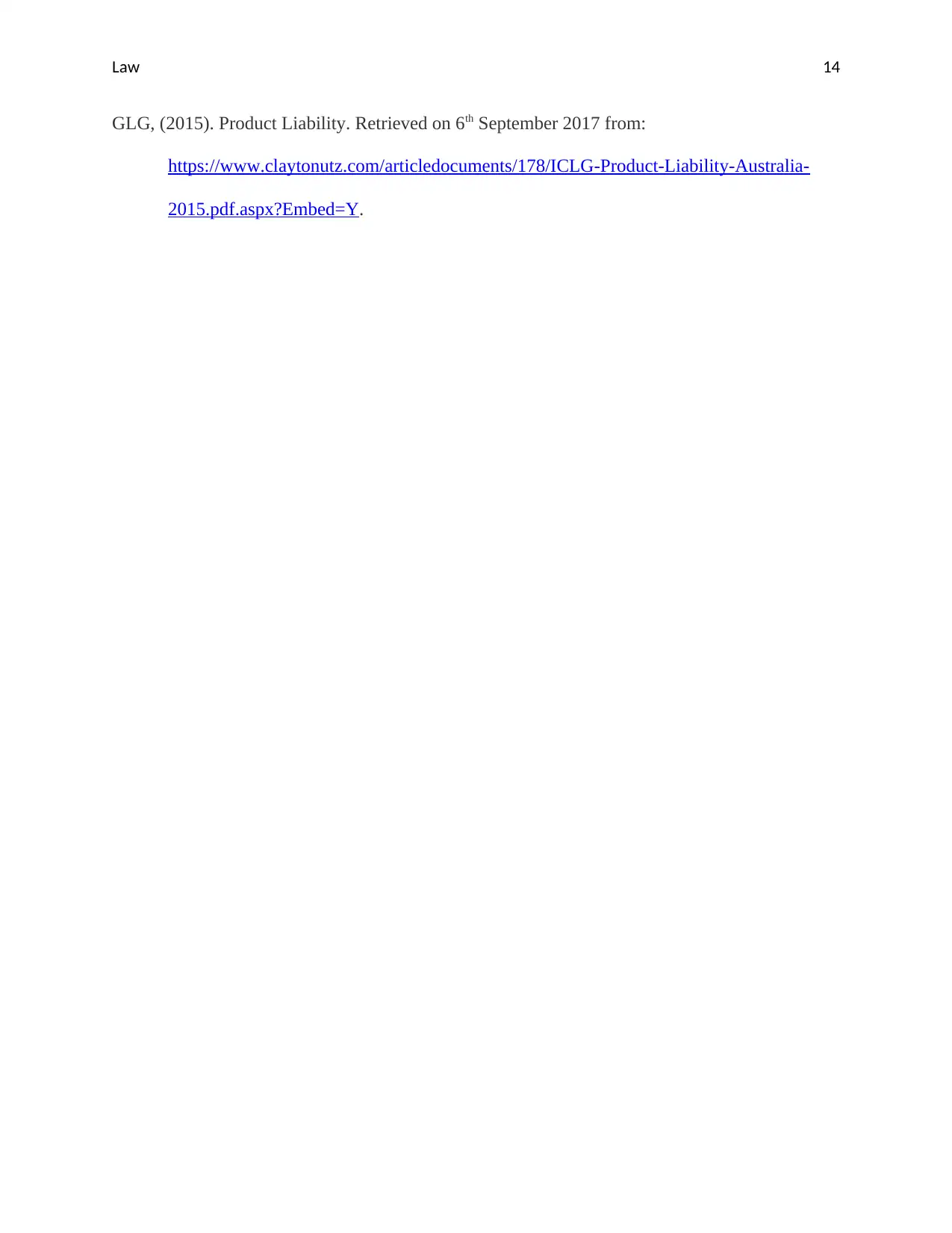
Law 14
GLG, (2015). Product Liability. Retrieved on 6th September 2017 from:
https://www.claytonutz.com/articledocuments/178/ICLG-Product-Liability-Australia-
2015.pdf.aspx?Embed=Y.
GLG, (2015). Product Liability. Retrieved on 6th September 2017 from:
https://www.claytonutz.com/articledocuments/178/ICLG-Product-Liability-Australia-
2015.pdf.aspx?Embed=Y.
1 out of 14
Related Documents
Your All-in-One AI-Powered Toolkit for Academic Success.
+13062052269
info@desklib.com
Available 24*7 on WhatsApp / Email
![[object Object]](/_next/static/media/star-bottom.7253800d.svg)
Unlock your academic potential
© 2024 | Zucol Services PVT LTD | All rights reserved.




